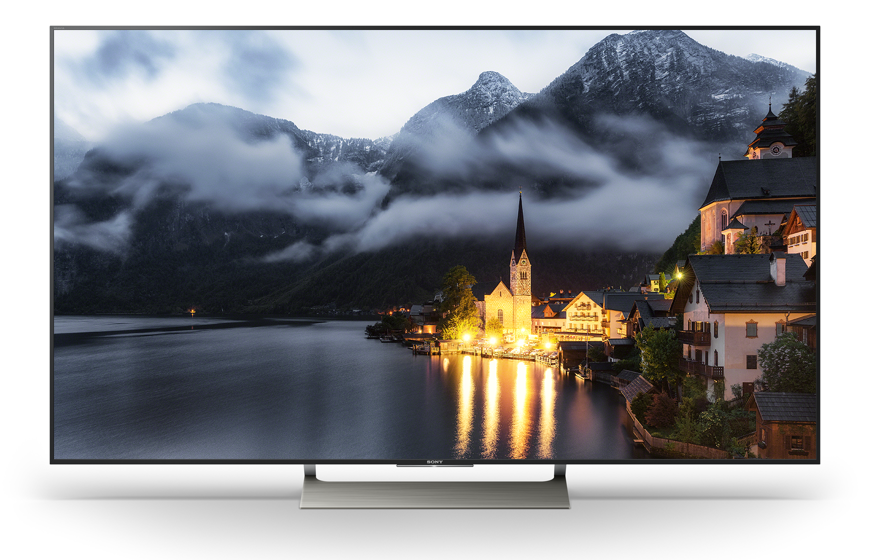Sony XBR-X900E Review
The new XBR-X900E model from Sony has a few minor picture quality downgrades from the XBR- X930E above it in Sony's 2017/2018 lineup. It has a different yet new processor included the 4K HDR X1 engine, which has been redesigned with upgrading content to look more like HDR content in mind. Video signal processing is a particular strength of Sony and has been for years. It has full array local dimming, one of the best features an LED/LCD TV can have when done right (which the X900E does). The last new feature I'll mention here is the X-tended Dynamic Range Pro 5X, which is a contrast enhancement booster mechanism, and not one of my favorite features, due the fact that it usually makes little difference to the viewer and can add flicker to the picture. All three of these features are slightly scaled down compared to the X930E, but are still very robust.
Other features included are a Triluminous display, widened color gamut for HDR, Motionflow XR technology, and 4K X-reality Pro, are all good technologies left over from last year.
How does the Sony X900E compare with an LG or Sony 4K OLED TV? We love OLED technology, so for a 4K UHD signal we give a strong edge to the LG OLED. But we believe Sony has the best processing and outer panel of the 4K TVs, so for 1080p and lower signals we believe this TV outperforms the LG 4K OLED.
Strengths
Weaknesses

Picture Quality (Rating 93/100)
HDR (High Dynamic Range)
The focus TV feature for 2017/2018 is HDR. HDR extends the range that a pixel in an LCD TV can show. This applies to the brightness and luminosity of images. Contrast is enhanced by increased brightness rather than deeper blacks. Rather than just increase the brightness of the picture overall though, the real purpose of HDR is to increase contrast in various image areas of the picture. It improves the presentation in the brighter parts of the picture and this creates more contrast with surrounding darker parts of the picture. Since picture contrast is one of the primary features in improving perceived depth, HDR is considered a major picture quality improvement even though it may not increase the overall contrast of the panel a lot. Bright colors receive enhanced purity. A good HDR image will show better shadow detail, and the scenes that you will notice the most are those with light illuminating images, especially outside sunlight effects, or a room that has sunlight coming in through a window and illuminating parts of the room. HDR content is and will be in short supply for a while. However, Sony is not waiting on HDR content to attempt to show you an HDR quality picture. The X900E is equipped with enough processing firepower to enhance color and light in such a way as to somewhat mimic content that was originally produced in HDR. That's the goal with the new technologies full array backlight and X1 processor anyway.
Sony's backlight manipulation is a bit less conspicuous than that of Samsung, which I like.
Triluminous Display - Color Rendition - Contrast
This wide-gamut color technology has been fantastic for Sony for a couple years. It produces much more realism and true-to-life color renditions than most of Sony's competitors, and in general takes less calibration effort to obtain a proper picture solution. The HDR contrast enhancement technology works well with the Triluminous display to provide incredible light flow through colors and enhance areas of the on-screen picture which are lit by windows or lighting. This all adds up to a more 3-dimensional picture quality depth even with HD signals. This is what we're looking for. The colors are not over saturated as they are with some, but they still have plenty of pop and are beautiful. The outer panel on the X900E is what really sets it apart from the lower priced 4K Sony's. It's also what adds so much to the cost. It creates the depth, richness, and vibrant colors and contrast that make this TV so desirable.
Up-Conversion of HD to 4K
Up-scaling and conversion is the most important aspect of any 4K UHD TV for 2017/2018 due to the dearth of 4K content, and Sony is the best at it in my view. The reasons are the excellent combination of the 4K X-Reality PRO up-scaling Algorithm technology used with the new 4K Processor X1 engine. On the X900E panel a good HD signal just looks incredible. Movies are also excellent and we recommend a room light condition of moderate to low light for this TV to unleash its full capabilities.

Comments
Post a Comment